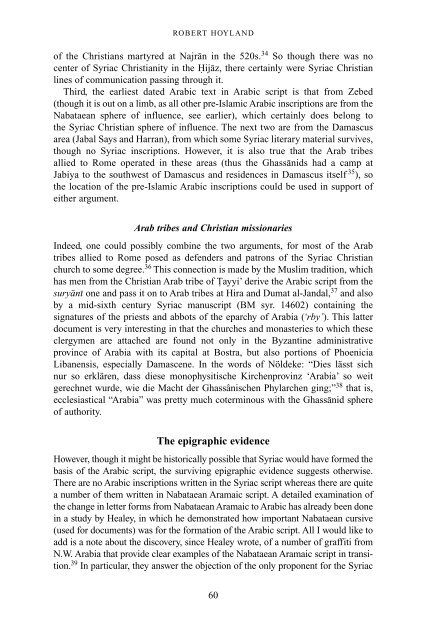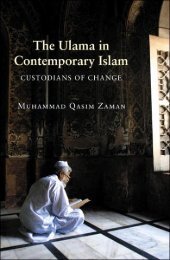The Qur'an in its historical context (pdf - Islam and Christian-Muslim ...
The Qur'an in its historical context (pdf - Islam and Christian-Muslim ...
The Qur'an in its historical context (pdf - Islam and Christian-Muslim ...
You also want an ePaper? Increase the reach of your titles
YUMPU automatically turns print PDFs into web optimized ePapers that Google loves.
ROBERT HOYLAND<br />
of the <strong>Christian</strong>s martyred at Najran <strong>in</strong> the 520s. 34 So though there was no<br />
center of Syriac <strong>Christian</strong>ity <strong>in</strong> the Hijaz, there certa<strong>in</strong>ly were Syriac <strong>Christian</strong><br />
l<strong>in</strong>es of communication pass<strong>in</strong>g through it.<br />
Third, the earliest dated Arabic text <strong>in</strong> Arabic script is that from Zebed<br />
(though it is out on a limb, as all other pre-<strong>Islam</strong>ic Arabic <strong>in</strong>scriptions are from the<br />
Nabataean sphere of <strong>in</strong>fluence, see earlier), which certa<strong>in</strong>ly does belong to<br />
the Syriac <strong>Christian</strong> sphere of <strong>in</strong>fluence. <strong>The</strong> next two are from the Damascus<br />
area (Jabal Says <strong>and</strong> Harran), from which some Syriac literary material survives,<br />
though no Syriac <strong>in</strong>scriptions. However, it is also true that the Arab tribes<br />
allied to Rome operated <strong>in</strong> these areas (thus the Ghassanids had a camp at<br />
Jabiya to the southwest of Damascus <strong>and</strong> residences <strong>in</strong> Damascus <strong>its</strong>elf 35 ), so<br />
the location of the pre-<strong>Islam</strong>ic Arabic <strong>in</strong>scriptions could be used <strong>in</strong> support of<br />
either argument.<br />
Arab tribes <strong>and</strong> <strong>Christian</strong> missionaries<br />
Indeed, one could possibly comb<strong>in</strong>e the two arguments, for most of the Arab<br />
tribes allied to Rome posed as defenders <strong>and</strong> patrons of the Syriac <strong>Christian</strong><br />
church to some degree. 36 This connection is made by the <strong>Muslim</strong> tradition, which<br />
has men from the <strong>Christian</strong> Arab tribe of Tayyi’ derive the Arabic script from the<br />
suryani one <strong>and</strong> pass it on to Arab tribes at Hira <strong>and</strong> Dumat al-J<strong>and</strong>al, 37 <strong>and</strong> also<br />
by a mid-sixth century Syriac manuscript (BM syr. 14602) conta<strong>in</strong><strong>in</strong>g the<br />
signatures of the priests <strong>and</strong> abbots of the eparchy of Arabia (‘rby’). This latter<br />
document is very <strong>in</strong>terest<strong>in</strong>g <strong>in</strong> that the churches <strong>and</strong> monasteries to which these<br />
clergymen are attached are found not only <strong>in</strong> the Byzant<strong>in</strong>e adm<strong>in</strong>istrative<br />
prov<strong>in</strong>ce of Arabia with <strong>its</strong> capital at Bostra, but also portions of Phoenicia<br />
Libanensis, especially Damascene. In the words of Nöldeke: “Dies lässt sich<br />
nur so erklären, dass diese monophysitische Kirchenprov<strong>in</strong>z ‘Arabia’ so weit<br />
gerechnet wurde, wie die Macht der Ghassânischen Phylarchen g<strong>in</strong>g;” 38 that is,<br />
ecclesiastical “Arabia” was pretty much coterm<strong>in</strong>ous with the Ghassanid sphere<br />
of authority.<br />
<strong>The</strong> epigraphic evidence<br />
However, though it might be <strong>historical</strong>ly possible that Syriac would have formed the<br />
basis of the Arabic script, the surviv<strong>in</strong>g epigraphic evidence suggests otherwise.<br />
<strong>The</strong>re are no Arabic <strong>in</strong>scriptions written <strong>in</strong> the Syriac script whereas there are quite<br />
a number of them written <strong>in</strong> Nabataean Aramaic script. A detailed exam<strong>in</strong>ation of<br />
the change <strong>in</strong> letter forms from Nabataean Aramaic to Arabic has already been done<br />
<strong>in</strong> a study by Healey, <strong>in</strong> which he demonstrated how important Nabataean cursive<br />
(used for documents) was for the formation of the Arabic script. All I would like to<br />
add is a note about the discovery, s<strong>in</strong>ce Healey wrote, of a number of graffiti from<br />
N.W. Arabia that provide clear examples of the Nabataean Aramaic script <strong>in</strong> transition.<br />
39 In particular, they answer the objection of the only proponent for the Syriac<br />
60



